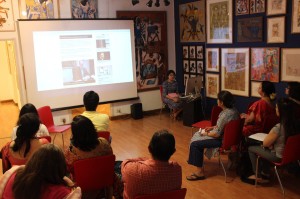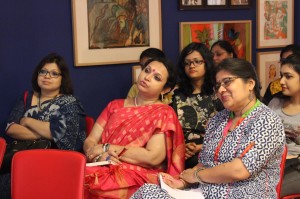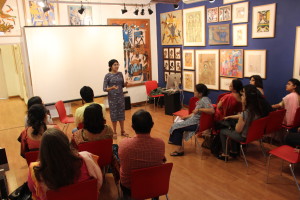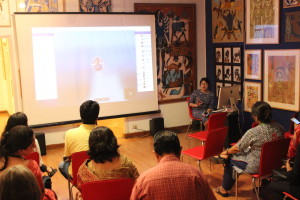‘2,000 rupee notes embedded with chips to enable tracking’ proclaimed one news channel. The other channel told its viewers that Yogi Adityanath, Chief Minister of Uttar Pradesh, had scrapped reservation in private colleges.
Joyeeta began the workshop on Media Literacy by showing these news clips both from so-called reputed news channels. The first one, shown on Zee News, went viral on Whatsapp.
After viewing the clips, the participants were asked to comment on them—whether at all they were credible news sources.
‘Tracking notes? Seems improbable,’ said one of the participants.
Another participant shared that someone she knew had actually tried to scrape away at the 2,000-rupee note to try and locate the elusive chip
One of the participants suggested that the wording of the second news article itself suggested that it might be fake.
The fact that both news items—widely shared and believed—were ‘fake’ shows an inability within us to be able to discern between what is right and wrong. It also indicates a certain ‘trigger-happy’ nature that we have developed—pass on whatever we get, without taking the time out to look into it with a critical eye.
The lines between what is real and what is fake has blurred to the point where one is indistinguishable from the other. Likewise, the definition of the word ‘media’. No longer is media restricted to just print, news channels and even radio. No longer is news being gathered, researched and disseminated by just journalists.
Fake news— news that are ‘intentionally and verifiably false and could mislead readers’— is not a new phenomenon. It has however, taken over our lives to the extent of having political implications—mainly due to the all-pervasive presence of social media—making consumers of all ages subject to it.
Participants in the workshop came from diverse backgrounds—some teachers of English and Social Studies in schools, some postgraduate students and some, students of Mass Communications. The concerns however were universal.
‘What channels or sites can one suggest to students for news?’
‘How does one find out the credibility of any news channel?’
‘How does one find out if the news is fake or not?’
The reasons why we believe in fake news are many. One, and perhaps the most obvious one, is laziness. We simply don’t make the effort to check and verify the sources of our information. The other is repetition. Joyeeta explained that when news is repeated our mental faculty to question reduces—if enough people are talking about it, then it must be true. This was a strategy employed by Goebbels and the Ministry of Propaganda during the Nazi regime. Another reason is layered sources of news.
Fake news comes in many forms. 100% fake news includes news about the death of a celebrity for instance. Then there is fake news that misuses data and fake news that has a misleading headline.
The motivation behind the creation of fake news can be political. It can also be monetary. Joyeeta gave the participants the example of teenagers in Macedonia creating fake news during the US presidential elections with the simple motivation of money.
Joyeeta then played a brief game using numbers with the participants. They were shown sets of numbers and asked to find a pattern linking the sets. The numbers increased by two in the first few sets—a pattern which was then abandoned. Once this hurdle was reached, participants were unable to recalibrate and rethink the pattern. This shows that our brains are inherently resistant to abandoning theories we begin to believe, subsequently seeking out information that confirms our theory.
Joyeeta mentioned a few useful websites where the veracity of a news item can be checked, like Hoax-Slayer, FactChecker and Alt News. She also suggested a checklist of sorts through which we can find out if news is false.
- Do you know who the source is or was it created by a common or well-known source?
- How does it compare to what you already know?
- Does the information make sense? Do you understand the information?
- Can you verify that the information agrees with three or more other sources that are also reliable?
- Have experts in the field been connected to it or authored the information?
- How current is the information?
- Does it have a copyright?
The participants had a conversation with Devanik Saha, a former journalist with IndiaSpend—the country’s first data journalism initiative. He said that at times news are not completely false but the message is misinterpreted, particularly when statistics are involved. One example he gave was the news that 90 % of Indians supported demonetization. This piece of news was proven to be fake because the sample size for this study was below 5,000—making it statistically unsound.
Anoo Bhuyan, a journalist with TheWire.in, then joined us over conference call. She has written a story on fake news and gave us insights on how to look critically at news. She said that every news article should have a byline—giving the name of the journalist who has written the story mentioned in their story—which can be checked. News organisations that only have a web presence go through much more rigour (in terms of fact checking) when publishing a news article than news organisations that publish online and also have a print presence.
She suggested to the teachers that they ask their students to read everything but also question what they read.
The participants then discussed ways by which they could take media literacy back to their classrooms. One of the participants suggested that they combine the analysis of media with that of bias, examining the role that bias plays in the representation of news. Another participant spoke about using Macbeth to work on the issue of different perspectives and representations.
One of the reasons why this workshop was conducted was to encourage educators to take this conversation—the question of what is fake news and how one can distinguish between what is fake and what is authentic—into their classrooms. To stimulate critical thinking about this issue in their students. Every one of the participants agreed that their role was to not only take this conversation forward, but also keep themselves abreast of what was happening in the field of media and social media.




